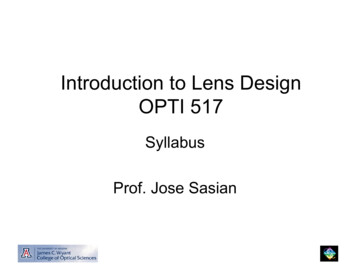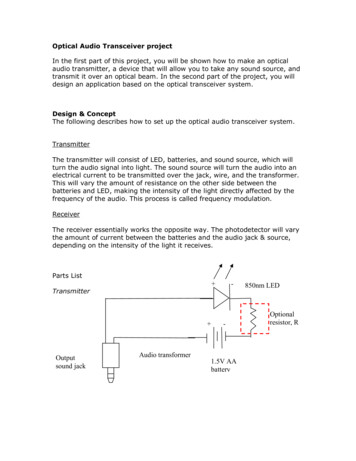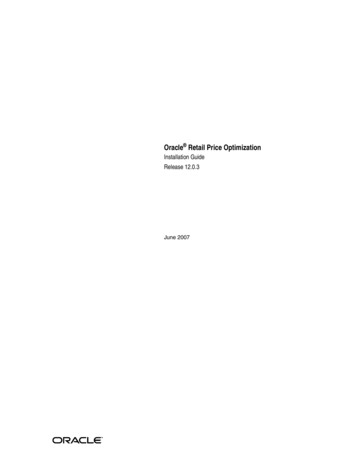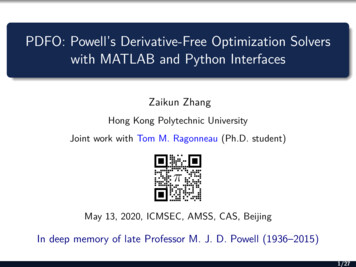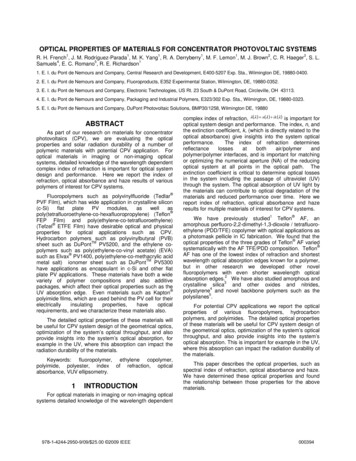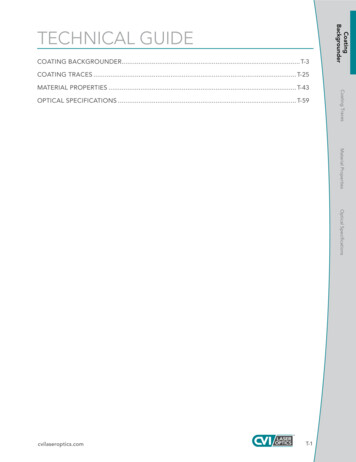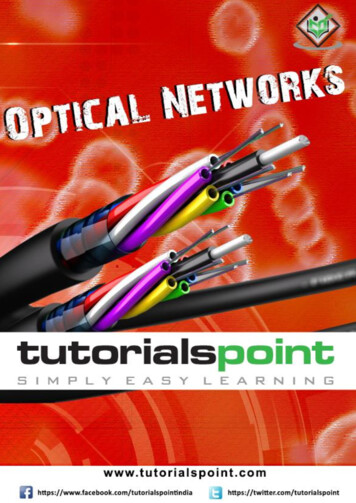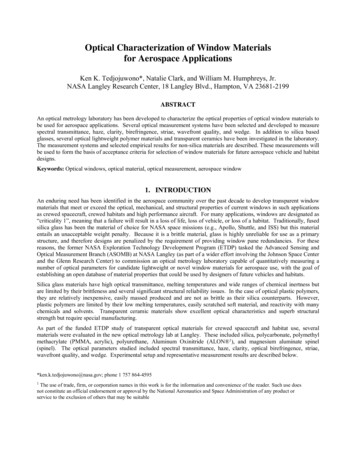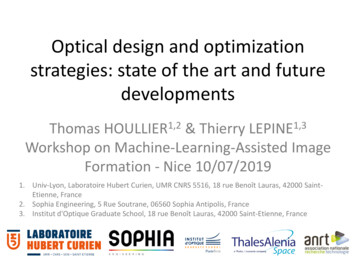
Transcription
Optical design and optimizationstrategies: state of the art and futuredevelopmentsThomas HOULLIER1,2 & Thierry LEPINE1,3Workshop on Machine-Learning-Assisted ImageFormation - Nice 10/07/20191. Univ-Lyon, Laboratoire Hubert Curien, UMR CNRS 5516, 18 rue Benoît Lauras, 42000 SaintEtienne, France2. Sophia Engineering, 5 Rue Soutrane, 06560 Sophia Antipolis, France3. Institut d'Optique Graduate School, 18 rue Benoît Lauras, 42000 Saint-Etienne, France
AuthorsThomas HOULLIER Working on a PhD on freeform imaging systems. Took an interest in search algorithms for opticaldesign.Thierry LEPINE Prof of optics, Institut d’Optique PhD supervisor of Thomas Main interests : optical design, radiometry, opticalmetrology ORCID ID : https://orcid.org/0000-0002-1102-920X2
How do optical designers work?OPTICAL DESIGN BASICS3
Optical design: Basic principleDesign systems to direct light usingoptical elements such as lenses,mirrors, gratings, light guides etc.Two fields are often distinguished (although the frontier blurs more and more):ImagingEg. telescope designLightingEg. reflector designThe core simulation tool is raytracing, complemented in rarer cases by wavepropagation models, finite element method etc.4
Modeling imagers: classicphotographic lensWe raytrace (Snell law) bundles of raysthrough the system to assess the imagequality.One possible criterion is the spread ofimpacts on the image plane. The set ofthese impacts is referred to as a spotdiagram. Small spot Good image quality Big spot Bad image quality5
Formulation as optimization problemEvery spherical lens can be seen as having 5 variableparameters: Curvatures 𝑐1 , 𝑐2 Index of refraction 𝑛 Center thickness and distance to next element 𝑡, 𝑒A simplistic merit function (scalar function of the systemparameters) for spherical photographic lenses can be:𝑆𝑝𝑜𝑡𝑟𝑎𝑑𝑖𝑢𝑠 (𝑐𝑖 , 𝑛𝑖 , 𝑡𝑖 , 𝑒𝑖 )We want to find the set of system parameters giving the lowest score, which ishere the best image quality.Many other optical performance criteria exist: Distortion, Modulation TransferFunction, sum of aberrations etc. etc.6
Solving the optimization problemA search strategy simulates the raytracing through systems with varying parameters ofradii of curvature and thicknesses until good performance is achieved. 7
Some constraints and infeasible casesConstraints Computation still possible We want to penalize these casesAnd many,many moreColliding elementsImpossible lensesUnevaluable cases Computation is usually just thrown outPackaging constraintsTotal internalreflectionRays missingelements8
Tools available Commercial programs are available from multiplevendors. They provide the possibility to model everycommon optical component. In imaging orlighting applications. Some programs in lighting start leveraging GPUs,but still not the norm. They are mostly GUI programs. Modularity can bedifficult to achieve between raytracer andoptimization engine.9
Design resourcesOptical system optimization problems are generally too hard for the tools wehave. Designers rely on catalogs of starting points and search for systems thatare close to their own target specifications.We can cite books: Smith, Warren J. "Modern optical engineering: the design of opticalsystems.“(1966) Welford, W. T., and R. Winston. "High collection nonimaging optics." New York:Academic Press, 1989 (1989). Laikin, Milton. Lens Design. CRC Press, 2001.And patents (radii of curvatures, thicknesses etc. are patented):US3504961A (expired)US3802765A (expired)10
Designer’s experienceOptical designers rely on their experience and bag of tricks. Examples: Being able to divide an optical systems into more or less definitefunctional blocks (see also zoom lenses):The designer then knows which partof the system to modify and inputinto the automated search methods. Looking at incident angles on optical surfaces.Looking at ray bundles through a design,the designer can identify weak points.Here the last lens will be very sensitive tomechanical positioning errors!It can also be an indication that thedesign isn’t the best one.11
DEMO: A doublet objectivelens in Zemax.12
What optical designers would like It is safe to say that the integrated search algorithms in any of the commercialprograms are not state of the art.The default in commercial tools is to start from a single starting point(although alternatives exist).Most of the time we use a single objective function (that covers all our specsand constraints).We need tools adapted to: High dimensionality. Non-linear behavior, ill conditioning. Hybrid variable types (continuous or discrete) in the case of glass selection. Independent of starting point. Many local optima in the merit function. Human interaction. It is often too hard or costly to express all thespecifications in the merit function and we discard many mathematicallyoptimal systems before finding the right one. But not too much. There are areas where we think the designer’sexperience can be replaced by datasets and models.13
Freeform optics and the problems we have in the design of thesesystems.THE ADVENT OF FREEFORM OPTICS14
What is freeform optics? Why do weuse it?We use complex surface shapes to obtain better optical systems in cases wherecompactness and performance is critical. It covers all fields of application. Two examples:Compact Head Mounted DisplaySpherical versus Freeform(to scale, eye pupil is 5 mm)Compact unobscured telescope (TMA)for nanosatellite Earth observation.We need freeform optics to obtain atelescope that has: Compactness No obscuration Performance15
Freeform surfaces mathematicaldescriptionsBy convention, we call “freeform” optical surfaces that do not possess an axisof rotational symmetry.The most popular type of freeform model is 2D polynomials. Otherrepresentations include grids of altitude and normals, piecewise patches etc.z x, y cx x 2 c y y 21 1 1 x cx x 1 y c y y2222 a j Z j x, y jBiconicbase shapeSee also:Broemel, A., Lippmann, U. & Gross, H. (2017). Freeform surface descriptions. Part I: Mathematicalrepresentations. Advanced Optical Technologies, 6(5), pp. 327-336Freeformcomponent16
Problems we encounter The dimensionality of optimization problems goesfrom 10 to dozens or hundreds. The evaluation cost of these systems is higher. Optical designers have no experience or bag of tricksto rely on in freeform optics. There are no large collections of starting points todraw from. Patenting is becoming rarer.Optical designers are facing harder than ever designproblems with a lack of appropriate tools and resources.17
Hooks into how machine-learning experts could contribute to opticaldesign (in the view of optical designers) and related subjects.SUBJECTS FOR MACHINE-LEARNING INOPTICAL DESIGN (NON-EXHAUSTIVE)18
Optimization variable typesOptimization strategies must take into account the different types of variables.Decisions are what human optical designers would do with the software. Applyingcomplex automated decision processes to optical design is not yet investigated. Radii of curvature Freeform coefficients Geometrical positions(length and angles)Continuous Optical glasses CoatingsDiscrete Adding or removingelementsDecision19
Using costly simulation resultsWe can include more in-depth but costly analysis in our objectives.The synthesis of fast, superficial analysis and costly, in-depth analysis in theoptimization process is usually done by the designer. Automated frameworksare lacking.Tolerancing analysis.Monte Carlo simulations of perturbedoptical systems.Straylight analysis.Raytracing millions/billions of rays tocheck for unintended light paths underconditions of diffraction, diffusion etc.leading to degraded performances.20
Search algorithms As a general rule, we do not use state of the artsearch algorithms.We have done some work in applying varioussimple search algorithms to conventional andfreeform optical design [1].We are collaborating with experts to apply stateof the art algorithms to optical design [2].Our current conclusion is that advanced algorithmsallow: Reaching good optical systems faster incomputational time Reaching lower global minima (even in simplecases!). No single starting point needed.1.2.Search algorithms involve findingglobal minima in functions searchspaces.Thomas Houllier and Thierry Lépine, "Comparing optimization algorithms for conventional and freeform opticaldesign," Opt. Express 27, 18940-18957 (2019)Maxim Sakharov, Thomas Houllier and Thierry Lépine. “Optimization of Optical Systems with the Mind EvolutionaryComputation Co-Algorithm”. 4th International Scientific Conference Intelligent Information Technologies for Industry.(submitted)21
Leveraging analytical surrogate modelsAnalytical optical aberration theories canbe used to assess the optical quality of asolution. Faster (in most cases) than raytracingsimulations. Easier access to derivatives. Usually does not describe the detailedperformance of optical systems.These theories are: Well known for axio-symmetricspherical systems (Seidel) Under research for the general case offreeform optics (Nodal aberrationtheory) [1-3].1.2.3.Analytical models can be used toguide the optimization processGuohao Ju, Hongcai Ma, Zhiyuan Gu, and Changxiang Yan "Experimental study on the extension of nodal aberration theory to pupil-offset off-axis three-mirroranastigmatic telescopes," Journal of Astronomical Telescopes, Instruments, and Systems 5(2), 029001 (9 April 2019).https://doi.org/10.1117/1.JATIS.5.2.029001K. P. Thompson, T. Schmid, P. Kao, and J. P. Rolland, "Recent Discoveries from Nodal Aberration Theory," in International Optical Design Conference and OpticalFabrication and Testing , OSA Technical Digest (CD) (Optical Society of America, 2010), paper IThB2.Kyle Fuerschbach, Jannick P. Rolland, and Kevin P. Thompson, "Extending Nodal Aberration Theory to include mount-induced aberrations with application to freeformsurfaces," Opt. Express 20, 20139-20155 (2012)22
Multi-objective optimizationNot typically included in optical design software.We generally merge all the objectives together in the same MF.Separating objectives is desirable since we can often accept compromises once weknow they exist.23
Neural networks[1] demonstrated that neural networks (NN) couldbe used to model freeform TMA.Inputs:1. FOV2. Focal length3. F#Output:Freeform telescope description with good opticalquality.This means that the complex interactions betweensystem geometry, surface shapes and opticalquality can be modeled by NN.We could imagine modelling: tolerances, designdecisions etc.A TMA layout1. Tong Yang, Dewen Cheng, and Yongtian Wang, "Direct generation of starting points for freeform off-axis three-mirror imagingsystem design using neural network based deep-learning," Opt. Express 27, 17228-17238 (2019)24
Concluding remarks Optical design relies heavily on computerized designof optical systems. Optical designers are facing challenges requiringbetter tools. Several leads for improvements using machinelearning are left unexplored (optical design is a smallcommunity, lack of experts).We can use the help ofoptimization/machine-learning/IA specialists!25
Call for collaborations What we feel is hampering research at the momentbetween optical design and machine learning is thefact that no simple and practical forward modelsoftware exists. The researchers must havecommercial licenses and make calls through an API. We should soon have black-box executablesmodeling optical systems based on a software wedeveloped. We think this will allow very easycollaborations and applying, at last, state of the artmachine learning methods to optical design.26
Thank you for your attention27
Optical system optimization problems are generally too hard for the tools we have. Designers rely on catalogs of starting points and search for systems that are close to their own target specifications. 10 We can cite books: Smith, Warren J. "Modern optical engineering: the design of optical systems."(1966) Welford, W. T., and R. Winston.


